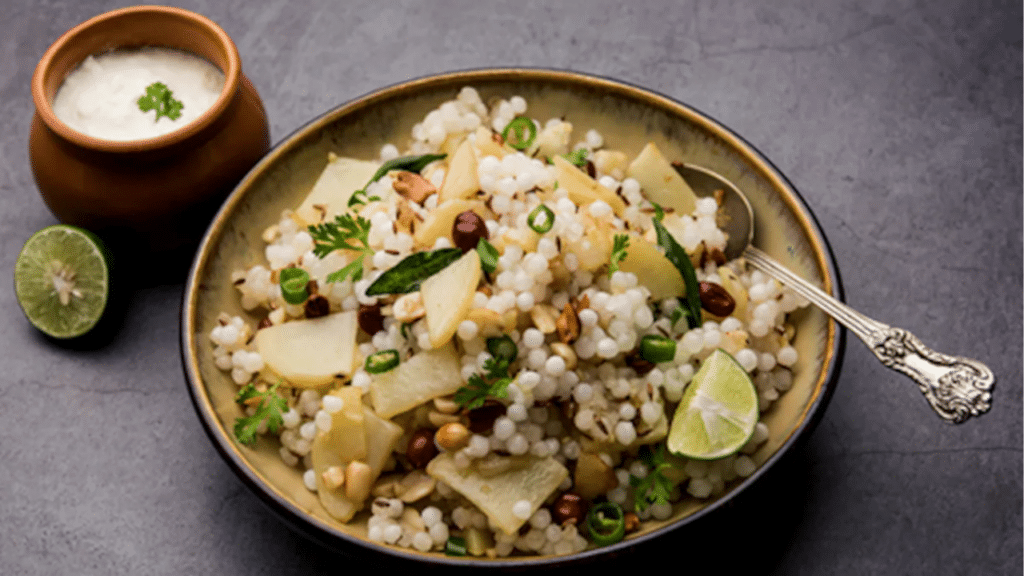Chaitra Navratri is a time of devotion, discipline, and celebration, observed with immense spiritual fervor across India. Beyond prayers and rituals, food plays a crucial role in this festival. While many devotees observe fasting (vrat) and follow a sattvik diet, the nine days are also an opportunity to indulge in a variety of delicious yet simple dishes that adhere to fasting norms. From light, wholesome meals to festive offerings, Navratri cuisine is a beautiful blend of tradition, taste, and devotion.
This blog brings you a collection of both fasting-friendly staples and festive feasts for Ashtami and Navami, ensuring that your Navratri meals are as nourishing as they are delightful.
Fasting Staples: Nourishing and Wholesome Vrat Recipes
During the nine days of Navratri, those who observe fasting follow dietary restrictions by avoiding grains, lentils, and certain spices. Instead, ingredients like sabudana (tapioca pearls), kuttu (buckwheat), singhara (water chestnut), samvat rice (barnyard millet), and fresh vegetables take center stage. Here are some must-try vrat-friendly dishes:
1. Sabudana Khichdi – A Classic Fasting Favorite
Read full recipe here A well-loved fasting dish, sabudana khichdi is light, non-greasy, and packed with energy. Made with soaked tapioca pearls, peanuts, cumin, and green chilies, this dish is both crunchy and soft in texture. Garnish with fresh coriander and serve with a bowl of cool yogurt for a complete meal.
Tip: To prevent sabudana from turning sticky, soak it properly and drain excess water before cooking.
2. Singhara Atta Cheela – A Light and Wholesome Pancake
Read full recipe here Singhara atta (water chestnut flour) is a gluten-free flour ideal for fasting. This cheela is crisp on the edges and soft inside, making it a perfect breakfast or evening snack. Pair it with vrat-friendly chutney or a bowl of curd.
Variation: You can add grated carrots or bottle gourd for extra nutrition and flavor.
3. Samvat Rice Khichdi – Comforting and Easy to Digest
Read full recipe here This khichdi is a wonderful alternative to regular rice dishes during fasting. Samvat rice (barnyard millet) is highly nutritious and pairs well with mild spices, making it both light on the stomach and filling. Serve it with a dollop of ghee and plain yogurt.
Why try it? It’s a one-pot meal that is easy to digest and can be prepared quickly.
4. Kaddu ki Sabzi – Sweet and Spicy Pumpkin Delight
Read full recipe here Pumpkin, or kaddu, is widely used in vrat meals due to its subtle sweetness and soft texture. This sabzi balances sweet and spicy flavors, making it a great side dish for kuttu or singhara rotis.
Flavor Twist: Add a dash of amchur (dry mango powder) for a tangy kick.
5. Vrat Ke Aloo – Quick and Flavorful Potato Stir-Fry
Read full recipe here A simple yet delicious dish made with boiled potatoes, cumin, and rock salt, vrat ke aloo is a comforting dish that pairs well with samvat rice khichdi or puris.
Serving Suggestion: Enjoy with fresh cucumber raita for a cooling contrast.
Festive Feasts: Special Dishes for Ashtami and Navami
Ashtami and Navami, the eighth and ninth days of Navratri, mark the culmination of the festival and are celebrated with grand feasts. These meals often include a combination of puri, halwa, and chole, offered as bhog to the Goddess before being served to family and guests.
1. Sooji Halwa – A Divine Sweet Treat
Sooji (semolina) halwa is an essential part of the Ashtami Kanya Pujan bhog and is loved for its rich, melt-in-the-mouth texture. Made with roasted semolina, ghee, sugar, and cardamom, this aromatic halwa is simple yet indulgent.
Tip: Add saffron or chopped nuts for an enhanced flavor.
2. Puri – The Perfect Fried Companion
Fluffy and golden-brown, puris made from wheat or kuttu atta (buckwheat flour) pair wonderfully with halwa and chole. These deep-fried breads are a staple for festive meals and add a celebratory touch to any spread.
3. Kala Chana – A Protein-Packed Offering
Black chickpeas (kala chana) are traditionally cooked on Ashtami and offered as bhog. They are slow-cooked with mild spices and served with puris, making for a wholesome meal.
Why is it special? It is believed that serving kala chana during Ashtami brings prosperity and good health.
Tips for Adapting Traditional Recipes to Modern Lifestyles
- Healthier Alternatives: Swap deep-fried puris with baked or air-fried versions.
- Gluten-Free Choices: Use kuttu, singhara, or rajgira flour instead of wheat.
- Low-Sugar Options: Replace refined sugar in halwa with jaggery or dates.
- Quick Cooking Hacks: Pre-soak ingredients like sabudana, chana, and samvat rice to reduce cooking time.
Offering Bhog: The Spiritual Essence of Navratri Meals
Before partaking in the feast, it is customary to offer food to the Goddess as bhog. Keeping the meal pure and satvik, avoiding garlic and onions, and maintaining a devotional mindset while cooking are considered auspicious. Fresh fruits, dry fruits, and milk-based sweets also make for excellent bhog offerings.
Savor the Essence of Navratri with Divine Flavors
Navratri is a festival that brings people together through devotion, tradition, and food. Whether you are fasting or feasting, these recipes offer a variety of wholesome, delicious, and spiritually uplifting options to enhance your celebrations. Try these dishes, embrace the sattvik lifestyle, and enjoy the divine flavors of Navratri!
For more food recipes, Check out Indian community Food recipes

